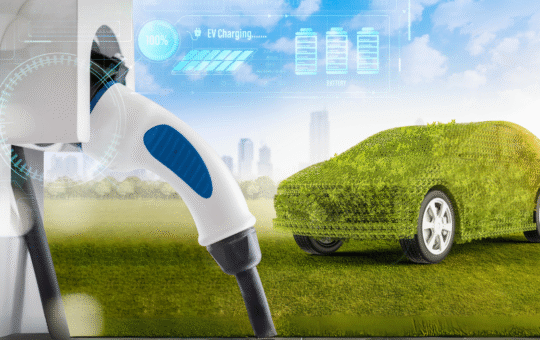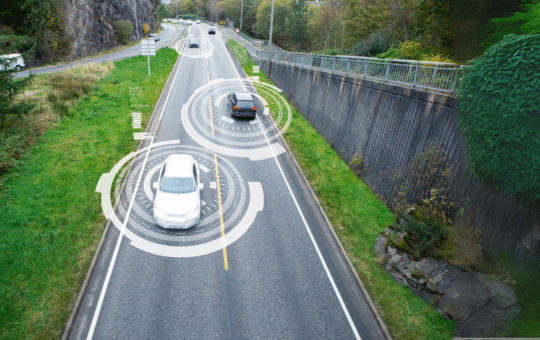
Level 5 Diploma in Automotive Control Systems and Embedded Systems
- Acquire in-depth knowledge of automotive control systems and embedded technologies, essential for modern vehicle performance.
- Gain expertise in the development and programming of embedded systems, including software, hardware, and firmware integration.
- Understand the design and operation of Electronic Control Units (ECUs) and their role in managing vehicle systems.
- Prepare for careers in automotive automation, vehicle safety, and control systems engineering.
- Understand the fundamentals of automotive control systems, including feedback loops and system modeling.
- Gain practical knowledge in developing and programming embedded systems for automotive applications.
- Learn how ECUs are integrated into various vehicle systems such as engine management, ABS, and active safety systems.
- Explore the role of sensors, actuators, and communication protocols in automotive control systems and autonomous driving.
- Introduction to Automotive Control Systems
- Overview of automotive control systems: architecture, components, and functions.
- The role of feedback loops, controllers, and system dynamics in vehicle operations.
- Embedded Systems in Automotive Applications
- Basics of embedded systems: hardware, software, and firmware integration.
- Programming embedded systems for automotive control using languages like C, C++, and Python.
- Electronic Control Units (ECUs) and Vehicle Systems
- Understanding ECUs: their structure, function, and role in vehicle automation.
- Study of various ECUs in automotive systems like engine control, braking, transmission, and HVAC.
- Advanced Sensors and Actuators in Automotive Systems
- Types of sensors used in vehicles, such as proximity sensors, temperature sensors, and pressure sensors.
- How sensors and actuators interface with control systems to enable vehicle functions.
- Vehicle Automation and Autonomous Driving Technologies
- Fundamentals of autonomous vehicles, including sensors, algorithms, and vehicle-to-vehicle (V2V) communication.
- Study of advanced driver-assistance systems (ADAS), such as adaptive cruise control, lane-keeping assist, and automated parking.
- Communication Protocols and Networking in Automotive Systems
- Exploring CAN (Controller Area Network) and other communication protocols used in vehicles.
- The role of in-vehicle networking and data transfer between control units and external devices.
- Pursue advanced qualifications in automotive systems engineering, vehicle automation, or control systems design (e.g., Level 6 diploma or Master's in embedded systems).
- Work as an automotive control systems engineer, embedded systems developer, or autonomous vehicle engineer.
- Specialize in developing and optimizing control systems for safety, performance, and automation in modern vehicles.
- Industry-Relevant Curriculum: Learn about cutting-edge technologies used in automotive control and embedded systems.
- Hands-On Experience: Gain practical skills in designing and programming embedded systems with real-world applications.
- Expert Instruction: Learn from experienced instructors with backgrounds in automotive control systems and embedded engineering.
- Globally Recognized Qualification: Enhance your employability with a qualification valued by leading automotive companies and tech firms.
Study Units
- Introduction to Automotive Control Systems
- Overview of automotive control systems: architecture, components, and functions.
- The role of feedback loops, controllers, and system dynamics in vehicle operations.
- Embedded Systems in Automotive Applications
- Basics of embedded systems: hardware, software, and firmware integration.
- Programming embedded systems for automotive control using languages like C, C++, and Python.
- Electronic Control Units (ECUs) and Vehicle Systems
- Understanding ECUs: their structure, function, and role in vehicle automation.
- Study of various ECUs in automotive systems like engine control, braking, transmission, and HVAC.
- Advanced Sensors and Actuators in Automotive Systems
- Types of sensors used in vehicles, such as proximity sensors, temperature sensors, and pressure sensors.
- How sensors and actuators interface with control systems to enable vehicle functions.
- Vehicle Automation and Autonomous Driving Technologies
- Fundamentals of autonomous vehicles, including sensors, algorithms, and vehicle-to-vehicle (V2V) communication.
- Study of advanced driver-assistance systems (ADAS), such as adaptive cruise control, lane-keeping assist, and automated parking.
- Communication Protocols and Networking in Automotive Systems
- Exploring CAN (Controller Area Network) and other communication protocols used in vehicles.
- The role of in-vehicle networking and data transfer between control units and external devices.
Upon completing this diploma, learners will:
- Understand the fundamentals of automotive control systems, including feedback loops and system modeling.
- Gain practical knowledge in developing and programming embedded systems for automotive applications.
- Learn how ECUs are integrated into various vehicle systems such as engine management, ABS, and active safety systems.
- Explore the role of sensors, actuators, and communication protocols in automotive control systems and autonomous driving.
This diploma is ideal for individuals interested in gaining advanced skills in automotive control systems and embedded systems. It is specifically designed for:
Automotive Control Systems Engineers
Professionals working in the development, integration, and optimization of control systems in modern vehicles, including those responsible for engine management, braking systems, and more.
Embedded Systems Developers
Engineers and developers who wish to specialize in the design, programming, and integration of embedded systems within automotive applications, including software, hardware, and firmware components.
Autonomous Vehicle Engineers
Individuals working in the field of autonomous vehicle development, focusing on the integration of sensors, algorithms, and control systems for self-driving technologies and automation.
Vehicle Safety and Automation Specialists
Those involved in the design and optimization of vehicle safety systems, including advanced driver-assistance systems (ADAS), adaptive cruise control, lane-keeping assist, and other autonomous driving technologies.
Automotive Electronics Engineers
Engineers with a focus on electronics, communication protocols (like CAN), and sensors, who want to deepen their knowledge of automotive systems and their interaction with embedded technologies.
Automotive R&D Engineers
Engineers working in research and development, particularly in areas of vehicle automation, control systems, and embedded technologies, aiming to drive advancements in vehicle performance and automation.
Students and Technicians in Automotive Engineering
Aspiring professionals aiming to specialize in automotive control systems, embedded systems, or autonomous vehicle technologies, with a strong foundation in electronics and programming.
Our assessment process is designed to ensure every learner achieves the required level of knowledge, skills, and understanding outlined in each course unit.
Purpose of Assessment
Assessment helps measure how well a learner has met the learning outcomes. It ensures consistency, quality, and fairness across all learners.
What Learners Need to Do
Learners must provide clear evidence that shows they have met all the learning outcomes and assessment criteria for each unit. This evidence can take different forms depending on the course and type of learning.
Types of Acceptable Evidence
Assignments, reports, or projects
Worksheets or written tasks
Portfolios of practical work
Answers to oral or written questions
Test or exam papers
Understanding the Structure
Learning outcomes explain what learners should know, understand, or be able to do.
Assessment criteria set the standard learners must meet to achieve each learning outcome.
Assessment Guidelines
All assessment must be authentic, current, and relevant to the unit.
Evidence must match each assessment criterion clearly.
Plagiarism or copied work is not accepted.
All learners must complete assessments within the given timelines.
Where applicable, assessments may be reviewed or verified by internal or external quality assurers.
Full learning outcomes and assessment criteria for each qualification are available from page 8 of the course handbook.
Top Courses
No results found.
Related Courses
Let's Get in touch
Deleting Course Review
Course Access
This course is password protected. To access it please enter your password below:



